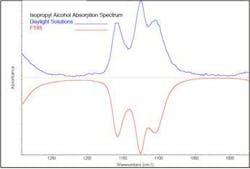Poway, CA--Daylight Solutions has achieved 324 cm-1 of continuous narrowband tuning from a single quantum-cascade (QC) gain structure in an external-cavity configuration. To the best of the company's knowledge, this is the broadest tuning reported for a standard QC structure.
The increased wavelength coverage is a result of both QC media development and design improvements to Daylight's external-cavity resonator.1 The media was tested in a version of the company's Swept Sensor fast-scanning pulsed cavity. The tuning range extended from 973 to 1297 cm-1, or 7.71 to 10.28 microns. This represents greater than 29% tuning of the center wavelength. The laser system operates at room temperature and without external cooling. The system is able to tune across the entire gain bandwidth of the QC in less than 10 ms. The peak power of the swept laser was greater than 80 mW.
The spectrum in the figure illustrates the broad tunability of the laser. The blue upper trace was obtained with the swept laser, an AC-coupled mercury cadmium telluride (MCT) detector, and a 10 cm vapor cell saturated in isopropyl alcohol. The trace is an average of 1000 sweeps taken over a 10 second period. The lower trace is an FTIR spectrum of the same vapor cell for comparison.
The need for broad tuning will continue to drive external-cavity quantum-cascade laser (ECqcL) development as it will facilitate molecular-sensing applications. The more complete spectra obtained from chips with broader tuning ranges will result in more accurate quantitative and qualitative determination of analytes in complex mixtures, since pattern-recognition software and fitting algorithms will have more data with which to work.
Daylight Solutions makes a commercial version of the broad-tuning pulsed laser system with more than 150 cm-1 of continuous tuning. For further info, contact Chris Armacost at [email protected].
1. U.S. Patent # 7,466,734

